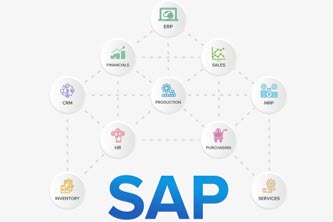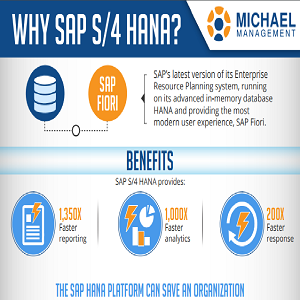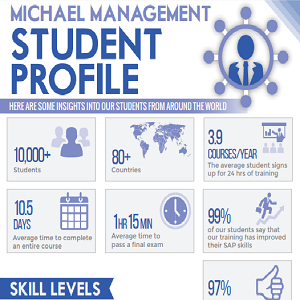SAP S/4HANA Roadmap Update
by Michael Management
 We recently hosted a webinar with Carl Dubler, the Senior Director of Product Marketing at SAP. Carl gave us an update on the SAP roadmap for S/4HANA, the next generation of ERP products, and some real-life descriptions of the S/4 HANA platform at work.
We recently hosted a webinar with Carl Dubler, the Senior Director of Product Marketing at SAP. Carl gave us an update on the SAP roadmap for S/4HANA, the next generation of ERP products, and some real-life descriptions of the S/4 HANA platform at work.
S/4 HANA is the next generation of Enterprise Resource Planning (ERP) products, with multiple deployment methods and a single-database model to consolidate tables. S/4HANA’s improvements make everything faster and easier, allowing users to do more.
What Are You Waiting For?
When any new software is released, many people are interested, but want to wait for the “third version.” They’ll wait to see how other people fare with it first and get in after all the “bugs” are worked out. S/4 HANA is now in its 4th release—the on-premise version is updated yearly, and the cloud version is updated quarterly. The naming convention uses the year and date of release; version 1709 was updated in September 2017 (read: S/4 HANA 1709 – what you need to know).
Some prefer to see others “go first,” and see how it works for them. S/4 HANA has only been available for three years, but since its release:
- 8,000 customers have bought S4/HANA
- 3,200 projects going on now
- 1,500 are running S/4 HANA now
S/4HANA is now the fastest-growing SAP solution to drive digital transformation in organizations, including SAP Cloud Platform (SCP).
Others are concerned about what converting will mean for their company or organization. There are three free tools available now that can show you what’s involved, the steps you’ll need to take, and how it would work specific to your organization.
Watch the entire webinar here:
How S/4 HANA Works
On a high level, using a simpler data model format and a much-improved user experience, S/4 HANA gives SAP users a new business capability and improves your company’s productivity. S/4 HANA gives you a complete, consistent choice of environment, and you can deploy it any way you want—on-premise, in the cloud, or in a variety of other ways (you can test this with our S/4 HANA access).
All the components and capabilities of S/4HANA can be explained by at least one component of the formula. There are many common themes, especially verification, taking some things and turning them into one thing.
Verification of disparate data sources, landscape consolidation, and drilling down to details are some of S/4HANA's most prominent features. One of the biggest tenets of S/4 HANA is taking a number of things and reducing it down to one thing. The simplification theme is not only the simpler data model, but also fewer components, and fewer steps to get there. These are two things that set S4/HANA apart from other SAP products.
Using the analogy of photography, most people understand taking a picture on their smartphones and sending it to someone via text, email, or a form of file sharing. But previously, to send someone a picture, there were multiple steps:
- Take the picture
- Bring it to the lab and have it developed
- Return to pick up your pictures
- Select the one to send
- Put it in an envelope and add a stamp
- Drop it in the mail and wait for them to receive it.
Although there were some individual steps you could speed up—such as 1-hour developing and overnight shipping—it was still a slower process than it is now because of the additional steps. It’s how S/4 HANA’s simpler data model allows you to do more by eliminating a number of steps that the current SAP programs require.
Better User Experience
S/4HANA is an in-memory ERP, and can reduce the number of needed tables from multiples to one. It’s not just faster, it’s a lot simpler, and a very strong value proposition (the 1709 version also maximizes Firm Expenser). With this system, you also can combine many transactions and analytics on one page. It offers a very improved user experience that’s much different.
Batching
Traditional databases had to be done in batches, requiring large numbers of database tables. But multiple batches involve running dependencies. Accounting people had to do this piecemeal, with lots of detailed handwork and lots of individual error corrections. (It’s why you never bother them during the end of the year.)
The new data model includes a financial module called Universal Journal, an object that’s counting everything. Instead of 30 tables, there’s only one—and it allows you to pass up reconciliation. Instead of reconciling 40 different tables, you only have one that displays and includes everything you need, already reconciled for you. Result: you can do a “soft close” anytime you want, and year-end closing isn’t nearly as difficult. It all happens in real-time.
Inventory
Does your company do PGI (Post Goods Issue)? If you’re a company that’s shipping goods you need to get an inventory of exactly what’s on each truck. This process can be fraught with problems, especially with so many processes and tables. But the HANA database is basically just one table—there’s no locking, and updates are faster and easier than before.
Reduced IT Complexity
With reduced storage, there is less replication, and less to load, there’s a faster restart after a failure. Using compression, it drops the amount of data you’re using and offers live exchanges for updates.
Landscape Consolidation
If you’re replacing a legacy database with HANA, the simpler database becomes. Applications that require their own hardware can be moved into the ERP. You can move them down into the core ERP, instead of using separate systems as you did previously.
This is especially useful for warehouse management, where you can simplify your IT and reduce your costs. A number of applications can run in the cloud—CRM, process service modules, sourcing, and others. It’s a simpler landscape for your IT department to run.
Key Updates For 1709
New innovations include:
- Embedded Transportation Management
- Consumer Products industry (“Catch Weight” Management)
- Commodity Management
- Service Core (CRM Add-on)
- Manufacturing
- Finance
- Procurement
Enhancements to existing innovations include:
- Industry To Core, Retail/Wholesale
- Enterprise Asset Management
- Sales
- Manufacturing
- Quality Management
- Extended Warehouse Management
- PLM
- Maximize SAP Fiori Experience
Finance
Machine learning with the cash app helps users make decisions, act faster, and improves fraud detection. More features are being added regularly. Everything is based on the S/4 HANA simplified data model, so if you want to start using these advances, you’ll need the model to do it.
Catch Weight Management
This is something that’s very important in food processing and consumer product business. Catchweight manages materials with two independent units of measure (parallel and variable quantity.) Also known as “approximate weight,” it’s used for things like:
- Livestock
- Meat
- Fish
- Dairy
- Fruit/Veg
- Lumber
- Leather
If You’re In IT
SAP now supports key things needed on the IT side (reliability, system recovery) that was done on a secondary server, synced to prevent losses. The 1709 release saw the secondary server just sitting there, waiting to be used for backup and recovery. But the second series allows you to use the other server to work alongside the first one. Giving more of the analytical workload to the secondary server opens up the system to be more productive, increase the workload, and work at a faster speed.
You can also scale out the workload across multiple servers. If you’re running a huge amount of data, you need a faster system. Scaling across more systems allows you to do that.
Carl used the example of a utility/power company, with millions of accounts. Customers want to access their accounts on the company’s website and make sure they have current and/or updated information. Using the multiple server model, you can do that easily, as well as have data available faster. HANA means that your issues are all addressed and that you have a “very mature” database to work with.
New Migration Cockpit
If you’re on a non-SAP system, you can use this new tool and bring in data from that system. It does a lot of pre-configuration mapping to make the process better and faster.
Planning For Adoption And Deployment
S/4 HANA is more than just a maintenance release because it provides more capabilities. If you’re interested in moving to it, there are four areas you can start on immediately:
- Readiness Check
- Business Value Advisor
- Prototypes
- Assess Custom Code Delivery
There are different deployment destinies with different transitions: on-premise, cloud and hybrid multi-tier systems. You can stay on-premise, or transition to cloud. There are also different options for public or private clouds, or if you use Amazon Web Services or Microsoft Azure. Make the choice that’s best suited for your company. You can use the free tools that are available today to help you decide what works for your company, your IT system, and your line of business.
Build Your Business Case
Identify the business processes that you can improve, and see new business capabilities. Then start building a business case for SAP S/4 HANA for your company.
The first step is to make sure that S/4 HANA will benefit you and your company. You’ll need to get your SAP usage from your IT department before you start. You can fill the form out manually, but your actual SAP usage will give you a better picture of what you can expect. Upload this information, which is how you use AP today, and it will tell you how your business processes will improve if you run S/4 HANA.
Transformation Navigation
You’ll discover your destination for S/4 HANA. This tool takes your actual usage data and gives you a roadmap that shows you how each function can be simplified. It works with all product options, and will also show you how you can keep some parts in your current SAP system if you have a need for it.
Plan Your Move And Ask IT Questions
Using the SAP Readiness Check tool, you’ll learn the technical requirements and actions for you to convert your system to S/4 HANA. You’ll begin to learn what it would take for your IT system to be converted once you upload your usage data. This tool will tell you what you need to plan for—especially useful if you’re in IT. Using your actual, real-time data will personalize this information just for you. You’ll see how you use SAP now, and what you can expect from it.
Questions
Three participants asked questions, and Carl generously answered them.
- Q: Must we use the Fiori interface of S/4 HANA?
- A: It’s the graphical interface that’s also available via mobile devices. In the public cloud, you do have to use it. If you have an on-premise or a private cloud, you can use the old one, perhaps for the users who do not like and refuse to use Fiori. While it’s not a requirement, much of the value of S/4 HANA for the data model and user experience comes from Fiori.
- Q: Is there more information on cloud or premise versions?
- A: Most customers are using the on-premise code line, but it isn’t necessarily being run on-premise. If a customer wanted to run it on Amazon, they would use the on-premise code line, but they would be running it in a private cloud. If it were a public cloud, they would just buy a subscription to that version. We’d be in control and handle everything for the customer—updates, maintenance, etc. This is also true if they’re using Amazon Web Service, Microsoft Azure, or any other service. Most are on-premise, in a private cloud—but our public cloud is growing as more customers are choosing to use it.
- Q: Are there any plans to bring SAP BT onto S/4 HANA?
- A: There are no plans, but I don’t know the roadmap. I haven’t spoken to the BT team about it, so I have no idea yet. Please send me an email and I will get an answer that way.
by Michael Management
More Blogs by Michael Management

How to Start a Career in SAP Inventory Management
SAP inventory management is an in-demand skill set from large companie...

Related Blogs

S/4 HANA 1709 - What you need to know
After a great holiday season it’s time to continue writing and s...
.png)




